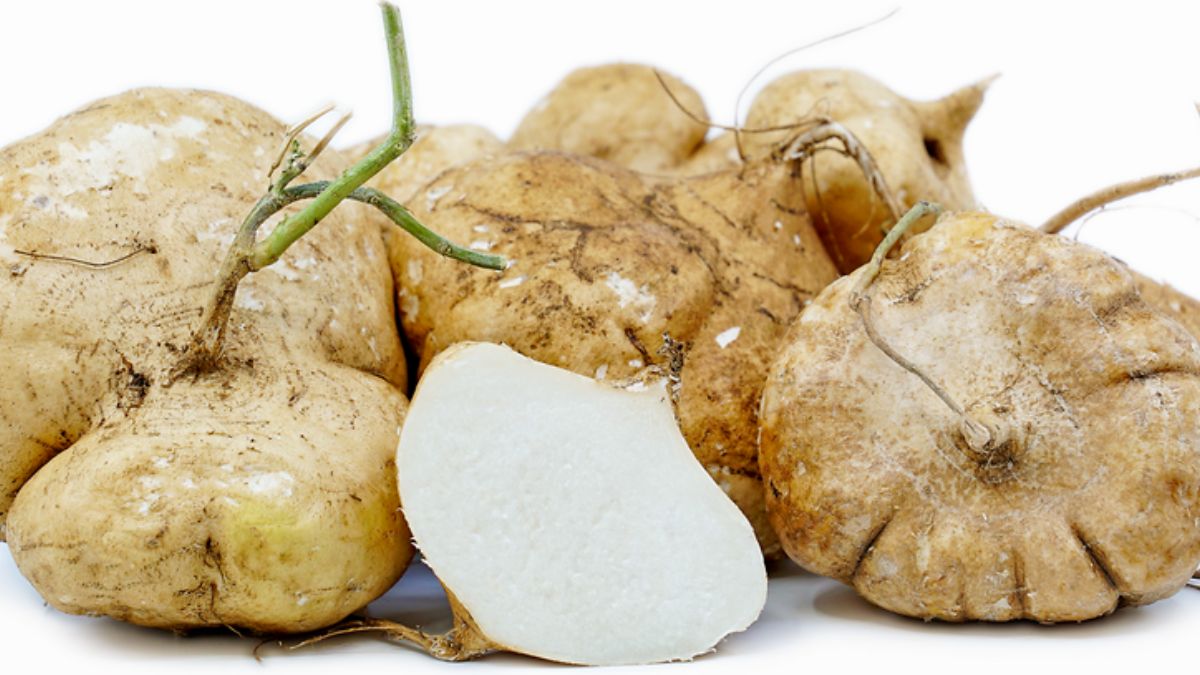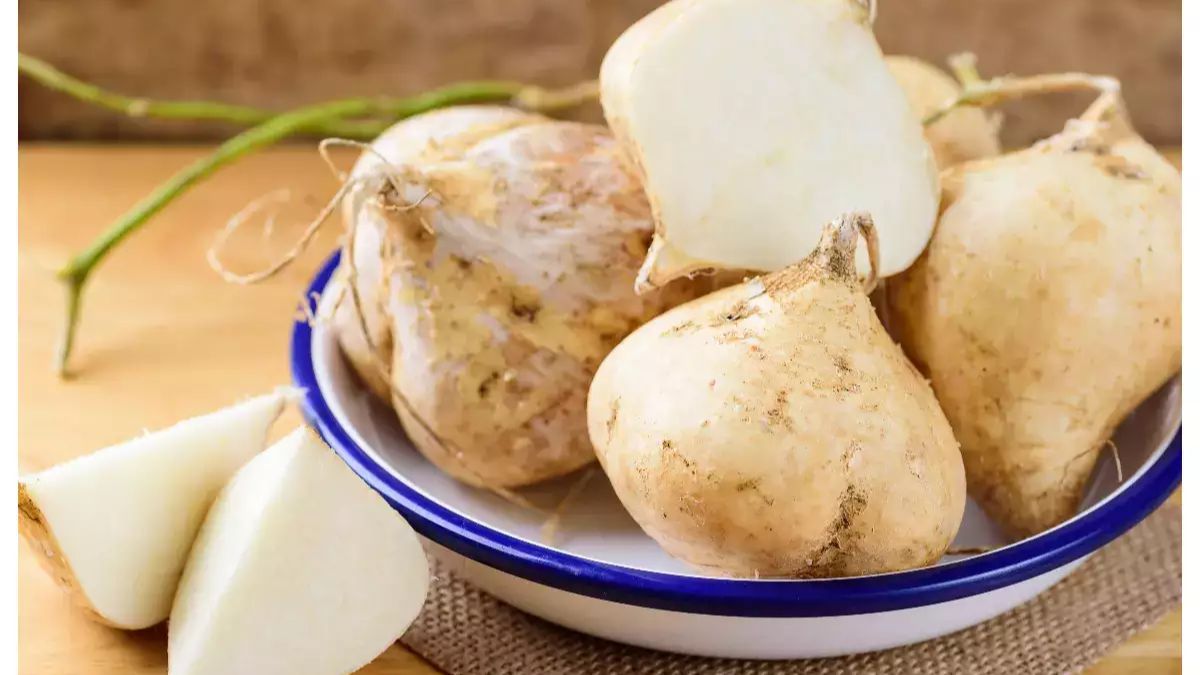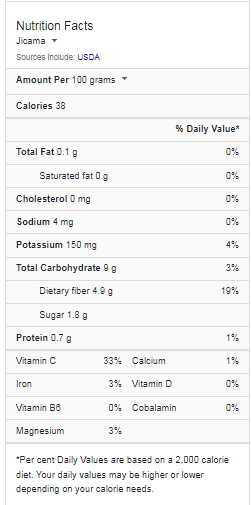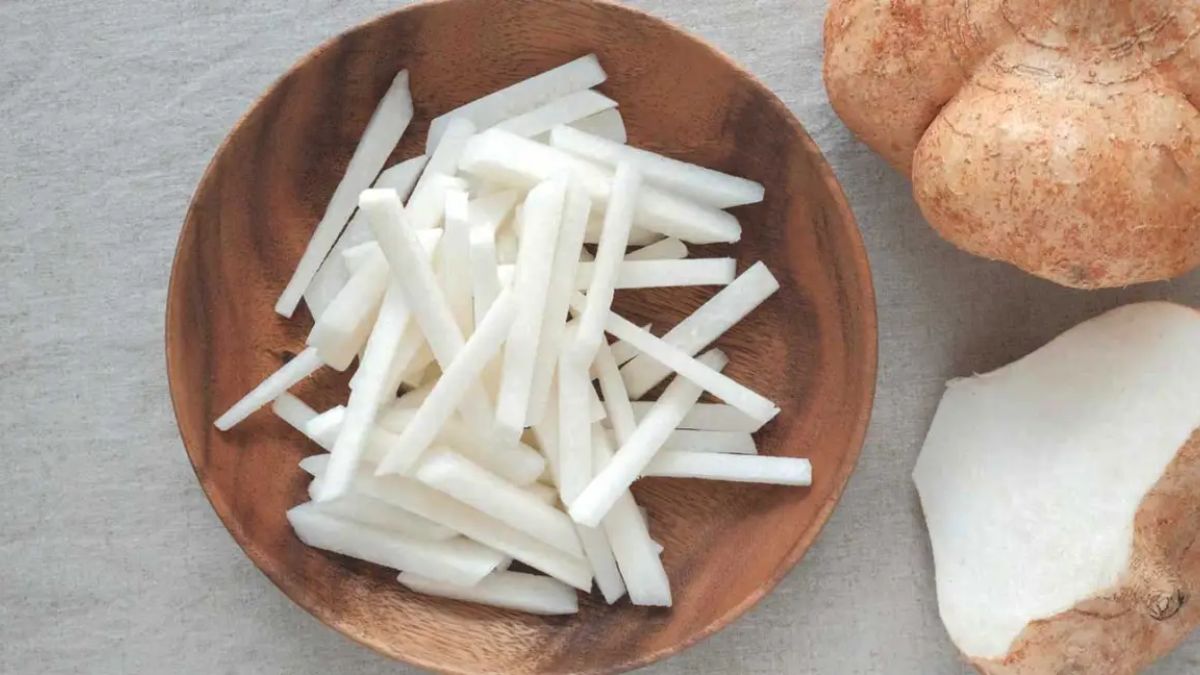Jicama is full of important vitamins and minerals. One cup has 20 milligrams of vitamin C, more than 25% of what an adult woman needs daily. Vitamin C is needed to make collagen and has been linked to a lower risk of some cancers. Vitamin C is also an antioxidant. Jicama antioxidants help us fight the damage from free radicals, which ultimately protect our DNA.
Jicama is a root vegetable with a starchy taste, like a potato or a turnip. The tuberous root has a slightly sweet taste but is low in sugar. This makes it a good source of carbs for people with diabetes and others trying to eat less sugar.
Jicama Nutirion Facts
What is Jicama?
Jicama is a root vegetable starchy like a potato but comes from the bean family. It is popular in Central American cooking and is grown in Mexico. It can be found in the produce section of most grocery stores, sometimes near hot peppers and cactus paddles.
The jicama grows in the garden on a vine that can get up to 20 feet tall. The only part of the plant that can be eaten is the bulbous root that grows underground. This root can be as small as a Gala apple or as big as two fists. This plant grows well in places like Mexico and South America, where it is hot all year round. Jicama has grown there for hundreds of years and is now also grown in parts of Asia and the Philippines.
People say that jicama tastes like a sweeter and more juicy potato. It is a starchy root vegetable. It doesn’t have many calories, sugars, or fats, but it has a lot of fiber and important vitamins and minerals. The root vegetable is safe to eat cooked or raw, and it can add texture to a wide range of meals. People with diabetes or trying to eat less sugar might like jicama. The flowers and beans, as well as the rest of the plant, are poisonous.
What are the Health Benefits of Jicama?
Healthful Source of Dietary Fiber
Jicama has a lot of fiber in it. A serving of raw jicama, 1 cup or 130 grams, has 6.4 grams fiber.
The Food and Drug Administration (FDA) of the United States says that most Americans do not get enough fiber. Dietary fiber should be eaten daily at 25 g for women and 38 g for men. The recommended daily amount for people over 50 is 21 g for women and 30 g for men.
The fiber in the diet can stop or treat constipation. It can also help keep a person’s blood sugar level steady, which may help treat or prevent diabetes. The FDA says that high-fiber diets also help people have regular bowel movements and lower the risk of heart disease.
Fiber intake was the most important indicator of health and longevity among the nutritional factors that were looked at in the study. Epidemiological data suggest that eating more fiber-rich foods may make you less likely to get sick as you age.
Also, Getting More Fiber in your Diet Might Help People Live Longer.
Bacteria and yeast that are good for your health are called probiotics.
A large group of bacteria lives in the gut of every person. Probiotics can help restore the natural balance of this community when they are eaten or taken as supplements. Probiotics are good for your health in many ways, like making your gut healthier and lowering your risk of getting some infections. Prebiotics are a kind of fiber that our bodies can’t break down. Prebiotics help probiotics grow by giving them something to eat. There are a lot of prebiotic fibers in jicama.
Regulates Blood
Bacteria and yeast that are good for your health are called probiotics.
Jicama is high in fiber and has a low glycemic index, so it doesn’t cause blood sugar levels to rise quickly. So, eating jicama as part of a healthy, well-balanced diet may help control blood sugar levels, making it a great choice for people with diabetes.
Good Source of Antioxidants:
It has a lot of vitamin C. Free radicals can damage cells and speed up aging. Antioxidants stop this damage and slow down the aging process. Vitamin C helps the immune system work better and keeps the body from getting sick. The National Center for Complementary and Integrative Health that oxidative stress may cause aging and several diseases like cancer, heart disease, and diabetes.
Fights Cancer
Jicama has a lot of inulin, which helps the body digest food and absorb nutrients. It also lowers the risk of getting colon cancer. Antioxidants, other vitamins, and trace minerals like selenium are found in jicama and help prevent oxidative damage to cells and lower cancer risk.
How to Use Jicama?
The most traditional way to eat this food is to peel it, cut it into strips, and eat it raw, usually with lemon or lime juice and chili powder. This sweet treat is sold in bags on the streets of Mexico. It is especially good on a hot day.
Because the flesh is so porous, jicama is good food for absorbing flavors. Please put it in salad chunks after marinating it with citrus and any spices you like. Or make it the main part and dress it up with a tangy dressing. Jicama tastes great with greens, olives, avocado, hummus, lime, grilled fish, and roasted pork. It can be thinly sliced and added to a sandwich for crunch or used instead of a corn tortilla in tacos.
Jicama is tasty when cooked, but you need to be careful with how hot it is. Instead, cook them in a pan over medium-low heat, lightly steam them, or roast them until they are finished. If you are making chili or a Mexican-style soup, add it at the end of the cooking process. Jicama has a texture like an apple, and you can keep that famous crunch if you don’t cook it too long.
How does Jicama Taste?
The food is a bit sweet and starchy, giving it some weight and making it feel more filling, but it’s still light enough that you can eat a whole root in one sitting. Jicama is crunchy and has an almost nutty taste, like a freshwater chestnut.
Jicama is a starchy root vegetable, like potatoes or turnips. It has thick, firm, brown skin and is available all year. The flesh of jicama is crunchy and juicy, and it tastes a bit like an apple but not as sweet. It tastes like nuts. Like potatoes, jicama has a low number of calories. Jicama is usually cooked like a potato but can also be eaten raw. When eaten raw, jicama tastes a bit like water chestnuts. Even though it looks like an apple, it doesn’t turn brown when you cut it. The part that wasn’t used could be saved for another time.
Where to Buy Jicama?
Jicama is mostly used in Latin American dishes, but you can find it all year long in the produce section of most grocery stores and specialty markets. Choose a firm, dry bulb with light brown skin that is smooth and free of spots. Don’t buy jicama that is soft to the touch or looks bruised and dried out. The circumference will also be different, ranging from the size of a green apple to a softball. As far as taste goes, size doesn’t matter.
Storage Tip
Jicama can be kept whole and unpeeled in the fridge for up to two weeks or on the counter for about a week as long as it isn’t in the sun or the kitchen gets too hot. After peeling the vegetable, you can cut it up and keep it in water in the fridge for a few days, but it’s best to eat it right away.
Conclusion
in the end, that jicama tastes like a sweeter and more juicy potato. It is a starchy root vegetable. It doesn’t have many calories, sugars, or fats, but it has a lot of fiber and important vitamins and minerals. People with diabetes or trying to eat less sugar might like jicama. The root vegetable is safe to eat cooked or raw, and it can add texture to a wide range of meals. The flowers and beans, as well as the rest of the plant, are poisonous.
When you look at jicama, a solid brown sphere, the word “bean” probably isn’t the first thing that comes to mind. Jicama looks like a root vegetable but is in the same family as peas. This family is called Fabaceae. Jicama, pronounced “hee-Kah-mah,” doesn’t look, feel, or act like a pea or a bean, but its crunchy, white flesh might taste a little like them. This vegetable is often used in Mexican food, and you can do much with it.



